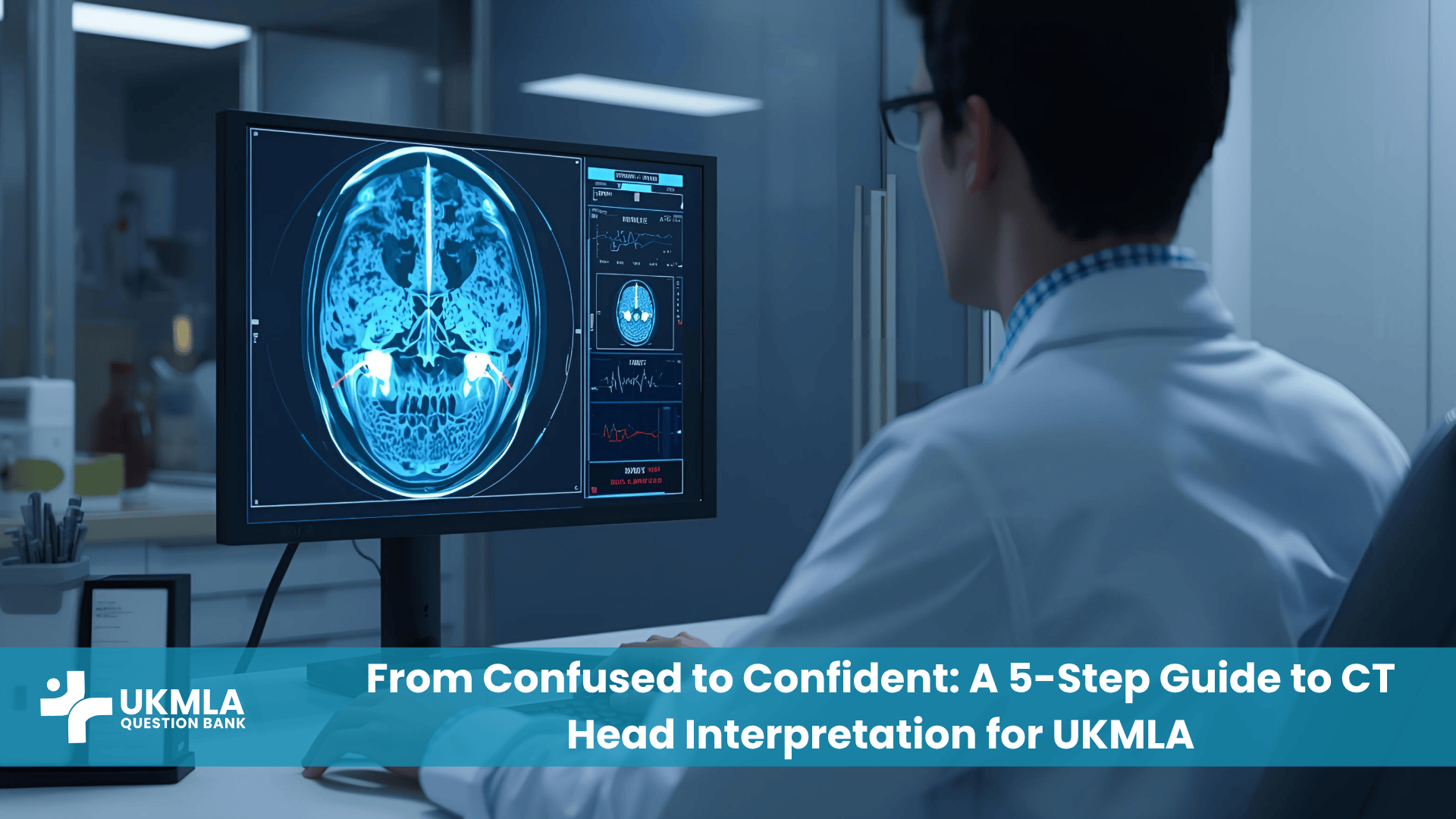Introduction
Mastering high-yield rheumatology for UKMLA is a crucial skill for any medical student, as it tests your ability to recognise patterns, link clinical signs to specific investigations, and understand the principles of managing chronic inflammatory conditions. The UK Medical Licensing Assessment (UKMLA) will expect you to differentiate between the common inflammatory and degenerative arthritides and to recognise the systemic nature of many rheumatological disorders.
This guide is designed to be your essential resource for this complex specialty. We will simplify the topic by focusing on the 7 most critical conditions and their key diagnostic markers. By understanding these core disorders, from Rheumatoid Arthritis to Gout, you will build the confidence to deconstruct any rheumatology-based SBA (Single Best Answer) question in your AKT (Applied Knowledge Test) and demonstrate your readiness for safe, evidence-based practice.
Table of Contents
ToggleThe Top 7 Conditions for High-Yield Rheumatology for UKMLA
Success in this area comes from pattern recognition. These seven conditions provide a framework that covers the vast majority of rheumatology questions you will face.
1. Rheumatoid Arthritis (RA)
RA is a chronic, systemic autoimmune disease characterised by a symmetrical, inflammatory polyarthritis.
Key Features: The classic presentation is pain and swelling in the small joints of the hands (MCPs, PIPs) and feet, typically sparing the DIP joints. The key symptom is prolonged early morning stiffness lasting more than 60 minutes, which improves with activity. Systemic features like fatigue and low-grade fever are common.
Essential Investigations & Markers: The most important diagnostic markers are Rheumatoid Factor (RF) and, more specifically, anti-CCP (anti-cyclic citrullinated peptide) antibodies. Inflammatory markers (ESR and CRP) will be raised. X-rays in later disease show loss of joint space, erosions, and soft tissue swelling.
Management Principles: The goal is to control inflammation and prevent joint damage. Management is led by a rheumatologist and is centred on Disease-Modifying Antirheumatic Drugs (DMARDs), with Methotrexate being the first-line choice. Flares are often managed with short courses of steroids.
2. Osteoarthritis (OA)
OA is a degenerative “wear and tear” condition and the most common form of arthritis.
Key Features: OA typically affects large, weight-bearing joints like the hips and knees, as well as the small joints of the hands (DIPs and PIPs). The pain is characteristically worse on activity and improves with rest. Morning stiffness is present but is usually brief (<30 minutes).
Table 1: Differentiating Inflammatory vs. Degenerative Arthritis
| Feature | Rheumatoid Arthritis (Inflammatory) | Osteoarthritis (Degenerative) |
|---|---|---|
| Stiffness | >60 mins, worse in the morning, improves with activity | <30 mins, worse after rest, improves quickly |
| Joints Affected | Symmetrical, small joints (MCP, PIP), wrists | Asymmetrical, large weight-bearing joints (hip, knee), DIPs |
| Systemic Features | Common (fatigue, fever, nodules) | Absent |
| Blood Tests | Raised ESR/CRP, RF/Anti-CCP positive | Normal |
Essential Investigations & Markers: This is primarily a clinical diagnosis. Blood tests are typically normal. X-rays are used to confirm the diagnosis and show the classic features summarised by the mnemonic LOSS: Loss of joint space, Osteophytes (bony spurs), Subchondral sclerosis, and Subchondral cysts. For more on this, our guide to high-yield musculoskeletal topics is highly relevant.
Management Principles: Management follows a stepwise ladder. The core is lifestyle modification (weight loss, physiotherapy). Simple analgesia (paracetamol, topical NSAIDs) is used first, followed by oral NSAIDs if needed. Joint replacement surgery is considered for severe, debilitating disease.
Clinical Pearl: “The single most important factor in differentiating inflammatory arthritis (like RA) from degenerative arthritis (like OA) in a vignette is the history of the joint stiffness. Prolonged morning stiffness that improves with activity points strongly towards an inflammatory cause.”
3. Gout & Pseudogout (Crystal Arthropathies)
These are conditions of acute, intense joint inflammation caused by the deposition of crystals.
Key Features: Both present with a single, red, hot, swollen, and exquisitely painful joint. Gout most classically affects the first metatarsophalangeal joint (the big toe), a condition known as podagra.
Essential Investigations & Markers: The definitive investigation for both is joint aspiration and polarised light microscopy of the synovial fluid.
Gout: Shows negatively birefringent, needle-shaped monosodium urate crystals.
Pseudogout: Shows positively birefringent, rhomboid-shaped calcium pyrophosphate crystals.
Management Principles: Management is split into acute and long-term.
Acute Attack: The first-line treatment is a high-dose NSAID (like naproxen) or colchicine.
Long-term Prophylaxis: Urate-lowering therapy, such as Allopurinol, is used to prevent future attacks but should not be started during an acute flare.
4. Systemic Lupus Erythematosus (SLE)
SLE is a multi-system autoimmune disease that can affect nearly any organ in the body.
Key Features: The presentation is incredibly varied. Look for a combination of non-specific constitutional symptoms (fatigue, fever, weight loss) and more specific features like a photosensitive “butterfly” rash, arthritis, serositis (pleurisy, pericarditis), and renal involvement (lupus nephritis).
Essential Investigations & Markers: ANA (Antinuclear Antibody) is a highly sensitive screening test (nearly all patients with SLE are ANA positive), but it is not specific. The most specific and important autoantibodies for diagnosis are anti-dsDNA and anti-Smith (Anti-Sm) antibodies.
Management Principles: Management is specialist-led and depends on the organs involved. Hydroxychloroquine is a cornerstone medication for most patients. Flares are often managed with steroids, and more severe disease may require immunosuppressants.
5. Ankylosing Spondylitis (Axial Spondyloarthritis)
This is the classic example of a seronegative (Rheumatoid Factor negative) spondyloarthropathy.
Key Features: The typical patient is a young man presenting with chronic, inflammatory back pain. The pain is worse at rest (especially in the morning) and improves with exercise. It can be associated with extra-articular features like anterior uveitis and aortitis.
Essential Investigations & Markers: Patients are often positive for the HLA-B27 gene. Inflammatory markers (ESR/CRP) are raised. X-rays of the sacroiliac joints may show sacroiliitis, and in late-stage disease, the classic “bamboo spine” can be seen.
Management Principles: The core of management is intensive physiotherapy and exercise. First-line medical treatment is with NSAIDs. For patients with persistent high disease activity, biologic DMARDs (like anti-TNF therapy) are used.
6. Giant Cell Arteritis (GCA) & Polymyalgia Rheumatica (PMR)
These are two closely related inflammatory conditions that affect older adults.
Key Features: GCA is a vasculitis of large and medium arteries. The classic presentation in a patient over 50 is a new-onset headache (often temporal), jaw claudication (pain on chewing), and visual disturbances. PMR presents with bilateral pain and stiffness in the shoulder and pelvic girdles. Many patients with GCA also have symptoms of PMR.
Essential Investigations & Markers: The hallmark finding for both is a very high ESR (often >100) and a raised CRP. The definitive diagnosis for GCA is a temporal artery biopsy, but treatment should never be delayed while waiting for this.
Management Principles: GCA is a medical emergency. If there are any visual symptoms, the patient requires immediate admission and high-dose intravenous steroids to prevent irreversible blindness. The British Society for Rheumatology (BSR) guideline on Giant Cell Arteritis provides the definitive UK pathway for management.
7. ANCA-Associated Vasculitis
This is a group of conditions characterised by inflammation of small blood vessels.
Key Features: These are multi-system diseases that often present with non-specific constitutional symptoms (fever, weight loss, myalgia) plus specific organ involvement, particularly of the kidneys (rapidly progressive glomerulonephritis) and the lungs (pulmonary haemorrhage).
Essential Investigations & Markers: The key diagnostic markers are ANCAs (Anti-Neutrophil Cytoplasmic Antibodies).
c-ANCA: Strongly associated with Granulomatosis with Polyangiitis (GPA).
p-ANCA: Associated with Microscopic Polyangiitis (MPA) and Eosinophilic Granulomatosis with Polyangiitis (EGPA). For more on interpreting these markers, see our guide on interpreting clinical data.
A Note on Autoantibodies: “Autoantibodies are a key part of the diagnostic puzzle in rheumatology. For the UKMLA, you must be able to link the key antibody (e.g., Anti-dsDNA) to the most likely clinical syndrome (e.g., SLE).”
Applying Rheumatology Principles to UKMLA Questions
SBA (Single Best Answer) questions in this area will test your ability to synthesise information.
A Systematic Approach to Joint Pain: When faced with a vignette about joint pain, your first step is to classify it. Is it mono- or polyarticular? Is it inflammatory or mechanical? Is it symmetrical or asymmetrical? Answering these questions will narrow your differential diagnosis significantly.
Linking Autoantibodies to Syndromes: Many questions will provide a clinical story and a positive autoantibody result. Your task is to put the two together to arrive at the most likely diagnosis. For more on this, our guide on tackling SBAs effectively is a crucial resource.
Frequently Asked Questions (FAQ): Rheumatology Essentials
Rheumatoid Factor (RF) is sensitive but not very specific (it can be positive in other autoimmune diseases and in healthy older people). Anti-CCP is highly specific for RA and is a better diagnostic and prognostic marker.
Methotrexate is a DMARD and a folate antagonist. Key side effects include bone marrow suppression, liver fibrosis, and pneumonitis. Patients require regular blood monitoring (FBC, LFTs), and it is teratogenic, so it is absolutely contraindicated in pregnancy.
A “seronegative” arthritis is one where Rheumatoid Factor (RF) is negative. The classic seronegative spondyloarthropathies include Ankylosing Spondylitis, Psoriatic Arthritis, and Reactive Arthritis.
Not necessarily. While ANA is sensitive for SLE, it is not specific. A positive ANA can be seen in many other autoimmune conditions and even in healthy individuals. A positive anti-dsDNA or anti-Sm is much more specific for SLE.
If there is any hint of visual symptoms or jaw claudication, the most important step is to start high-dose steroids immediately. Do not wait for investigations. This is a sight-saving emergency.
Both can present as a single, red, hot, swollen joint. However, a patient with septic arthritis is typically systemically unwell with a fever. In any case of an acute monoarthritis, joint aspiration is essential to rule out sepsis, which is a joint-destroying emergency.
Yes, absolutely. A patient with long-standing RA can develop secondary OA in their damaged joints. The key is to take a careful history to distinguish the inflammatory symptoms from the mechanical ones.
It is an episodic vasospasm of the small arteries, usually in the fingers and toes, triggered by cold. It causes a classic triphasic colour change (white, then blue, then red). It can be primary (benign) or secondary to an underlying connective tissue disease like scleroderma.
A common mnemonic for Gout is: Needle-shaped, Negatively birefringent, and yellow when parallel to the light. For Pseudogout, remember Positively birefringent, Polygon (rhomboid) shaped.
Focus on pattern recognition. Create tables comparing the key features of the major conditions. Then, use a high-quality UKMLA question bank to practice applying this knowledge to clinical vignettes that include autoantibody results.
Conclusion
Mastering high-yield rheumatology for UKMLA is about learning to think like a clinical detective. It requires you to take clues from the patient’s history, their examination findings, and specific diagnostic markers, and piece them together to form a coherent diagnosis.
By focusing your revision on these 7 core conditions and understanding their classic patterns, you will be well-equipped to handle the rheumatology questions in your AKT. Remember to always link the clinical picture with the autoantibodies and to prioritise the management of rheumatological emergencies like Giant Cell Arteritis.




